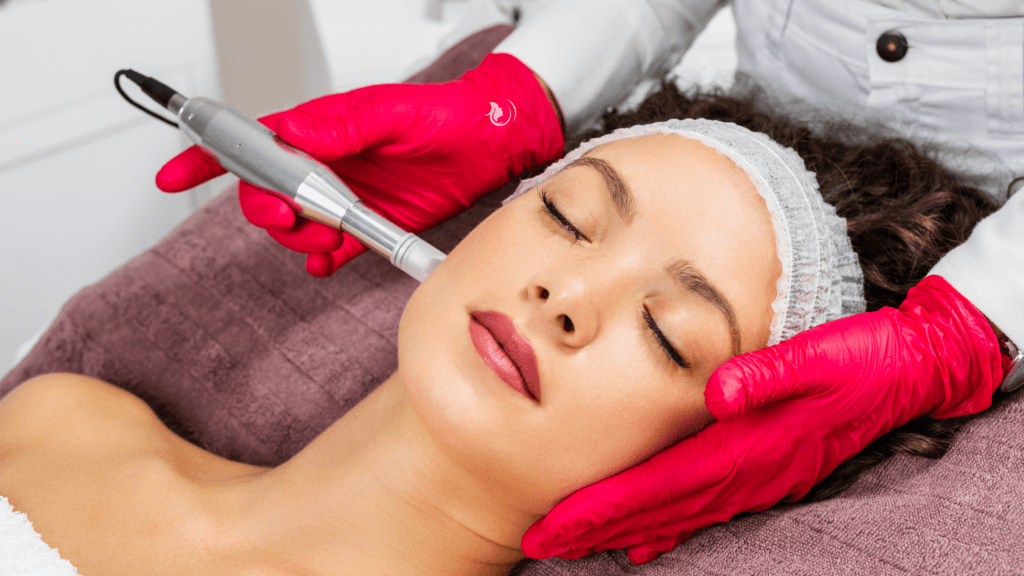Microneedling, also known as collagen induction therapy, is a minimally invasive cosmetic procedure that involves creating micro-injuries in the skin using tiny, sterile needles. This controlled damage stimulates the body’s natural healing response, which in turn promotes the production of collagen and elastin – essential proteins responsible for maintaining the skin’s firmness, elasticity, and overall youthful appearance.
How Does Microneedling Work?
During a microneedling session, a specialised device such as a Dermaroller or Dermapen is used to create tiny, controlled punctures in the skin’s surface. These microscopic punctures, often referred to as micro-injuries, are strategically designed to stimulate the body’s natural healing response without causing significant damage to the skin.
The process triggers the release of growth factors and cytokines, key signalling molecules that promote skin repair and regeneration. By initiating this controlled wound-healing process, microneedling helps to rejuvenate the skin from within, addressing a variety of concerns such as fine lines, wrinkles, and acne scars.
| Feature | Description | Benefits | Considerations/Potential Side Effects |
|---|---|---|---|
| Procedure | Tiny needles create controlled micro-injuries in the skin. | Stimulates collagen and elastin production. | Redness and swelling immediately after (usually subsides within 24-48 hours). |
| Mechanism of Action | Triggers the body’s natural healing process, promoting new skin cell growth. | Improves skin texture and tone. | Minor bleeding or bruising is possible. |
| Targeted Concerns | Fine lines and wrinkles, acne scars, surgical scars, stretch marks, large pores, uneven skin tone, hyperpigmentation. | Reduces the appearance of scars. | Risk of infection if proper aftercare isn’t followed. |
| Treatment Areas | Face, neck, décolleté, hands, and other areas of the body. | Minimises pore size. | Potential for temporary skin sensitivity or dryness. |
| Number of Treatments | Typically a series of 3-6 treatments spaced 4-6 weeks apart for optimal results. | Improves skin elasticity and firmness. | Not recommended for active acne breakouts, eczema, psoriasis, or certain other skin conditions. |
| Downtime | Minimal downtime (usually 1-3 days of mild redness and sensitivity). | Reduces the appearance of fine lines and wrinkles. | People with bleeding disorders or who are taking blood thinners may not be suitable candidates. |
| Results | Gradual improvement in skin texture and tone over several weeks and months. | Evens out skin tone and reduces hyperpigmentation. | Choosing a qualified and experienced professional is crucial to minimise risks. |
| Types of Microneedling | Traditional microneedling (using a dermaroller or microneedling pen), Radiofrequency (RF) microneedling (combines microneedling with radiofrequency energy). | Can be combined with topical serums (e.g., hyaluronic acid, growth factors) for enhanced results. | Results are not permanent and maintenance treatments may be necessary. |
| Cost | Varies depending on the provider, location, and area treated. | Can improve the appearance of stretch marks. | Can be uncomfortable, though numbing cream is typically used. |
Benefits of Microneedling
Microneedling has many benefits when it comes to anti-aging treatments. It helps to reduce wrinkles and fine lines by stimulating collagen production in the skin. It can also help improve the appearance of scars, enlarged pores, and stretch marks by creating microscopic wounds that encourage new cell growth. Additionally, microneedling can help even out skin tone and texture as well as reduce discolouration from sun damage or acne scarring.
- Reduction of fine lines and wrinkles
- Improved skin texture and tone
- Minimised appearance of pores
- Reduction of acne scars and other types of scarring
- Enhanced absorption of skincare products
Skin Concerns Treated by Microneedling
Microneedling is a versatile treatment that can address various skin concerns, such as:
- Ageing skin: fine lines, wrinkles, and loss of elasticity
- Hyperpigmentation: age spots, sun damage, and melasma
- Acne scars and other types of scarring
- Enlarged pores
- Uneven skin texture
How Often Should You Get Treatment?
The frequency of microneedling treatments depends on your individual needs and goals. Generally speaking, most people will need 3-6 sessions spaced 4-6 weeks apart for optimal results. However, some people may require more frequent treatments depending on their specific concerns or desired results. It’s important to consult with a dermatologist before beginning any microneedling regimen to ensure you’re getting the best possible treatment for your skin type and goals.
Effectiveness and Duration of Results
Microneedling has been proven to be an effective treatment for various skin concerns. While some individuals may notice improvements after just one session, optimal results are typically achieved after a series of treatments. The duration of the results may vary depending on factors such as the individual’s skin type, lifestyle, and skincare routine. However, with proper maintenance, the effects of microneedling can last for several months.


